The Analysis of Red Lead Endsheets in Rare Books from the Fung Ping Shan Library at the University of Hong Kong
Abstract
:1. Introduction
1.1. Insect Pests in Libraries and Archives
1.2. Control of Insect Pests in Libraries and Archives
1.2.1. Chemical Methods
1.2.2. Non-Chemical Methods
1.3. Materials Used for Paper and Books in China
1.4. Traditional Methods to Protect Papers in China from Insect Attack
1.5. Introduction to RED–ORANGE Papers in China
1.6. RED-ORANGE Papers at the Fung Ping Shan Collection, Library of the University of Hong Kong (HKUL)
2. Materials and Methods
3. Results
3.1. Undamaged ORANGE Papers
3.2. Damaged ORANGE Papers
4. Discussion
4.1. Traditional Treatment Methods and Current IPM Methods in China and Asia Today
4.2. Current IPM Methods and Treatment of Books in Europe Today
5. Conclusions
Author Contributions
Funding
Institutional Review Board Statement
Informed Consent Statement
Data Availability Statement
Acknowledgments
Conflicts of Interest
References
- Hickin, N. Bookworms—The Insect Pests of Books, 2nd ed.; Edwards, R., Ed.; Richard Joseph Publishers LTD.: Nottingham, UK, 1992. [Google Scholar]
- Blades, W. The Enemies of Books; Elliot Stock: London, UK, 1887. [Google Scholar]
- Brokerhof, A.W.; Zanen, W.B.; Watering, K.; Porck, H. Buggy Biz, Integrated Pest Management in Collections; Netherlands Institute for Cultural Heritage (ICN) and IADA: Amsterdam, The Netherlands, 2007. [Google Scholar]
- Trematerra, P.; Pinniger, D. Museum pests–Cultural heritage pests. In Recent Advances in Stored Product Protection; Springer: Berlin/Heidelberg, Germany, 2018; pp. 229–260. [Google Scholar]
- Pinniger, D. Integrated Pest Management in Cultural Heritage; Archetype Publications: London, UK, 2015. [Google Scholar]
- Pinniger, D.; Lauder, D. Pests in Houses Great and Small: Identification, Prevention and Eradication; English Heritage: Swindon, UK, 2018. [Google Scholar]
- Pinniger, D. Managing Pests in Paper-Based Collections; Preservation Advisory Centre, British Library: London, UK, 2012; p. 15. [Google Scholar]
- Querner, P. Insect pests and integrated pest management in museums, libraries and historic buildings. Insects 2015, 6, 595–607. [Google Scholar] [CrossRef] [PubMed]
- Ho, Y.-H.; Hsiao, Y.; Terayama, M.; Chan, M.-L. Ultramorphological characteristics of Falsogastrallus sauteri pic (Coleoptera: Ptinidae) and a new species of Cephalonomia Westwood (Hymenoptera: Bethylidae): A book-boring beetle and its natural enemy in Taiwan. Insects 2020, 11, 223. [Google Scholar] [CrossRef] [PubMed]
- Querner, P.; Cabral, U.; Fohrer, F. First record of Gastrallus laticollis pic 1929 (Coleoptera: Bostrichoidea: Ptinidae) in Sri Lanka. J. Entomol. Res. 2021, 45, 351–355. [Google Scholar] [CrossRef]
- Silva, C.R.; Anjos, N.D.; Zanuncio, J.C.; Serrão, J.E. Damage to books caused by Tricorynus herbarius (Gorham) (Coleoptera: Anobiidae). Coleopt. Bull. 2013, 67, 175–178. [Google Scholar] [CrossRef]
- Watson, J.R. A tropical book worm in Florida. Neogastrallus librinocens Fisher, in Florida (Anobiidae, col.). Fla. Entomol. 1943, 26, 61–63. [Google Scholar]
- White, R.E. The Mexican book beetle, Catorama herbarium, established in the United States (Coleoptera: Anobiidae). Ann. Ent. Soc. Am. 1963, 56, 280–285. [Google Scholar] [CrossRef]
- Museum of Fine Arts, Boston. Bookworm. In Conservation and Art Material Encyclopedia; Online; Available online: http://cameo.mfa.org/wiki/Bookworm (accessed on 30 June 2022).
- Manachini, B. Alien insect impact on cultural heritage and landscape: An underestimated problem. Conserv. Sci. Cult. Herit. 2015, 15, 61. [Google Scholar]
- Moşneagu, M. The preservation of cultural heritage damaged by anobiids (Insecta, Coleoptera, Anobiidae). Ann. Ser. Biol. Sci. Acad. Rom. Sci. 2012, 1, 32–65. [Google Scholar]
- Querner, P. IPM, the grey silverfish and other species of Lepismatidae in Austrian museums. In Proceeding of the ICUP Conference, Barcelona, Spain, 27–29 June 2022. [Google Scholar]
- Aak, A.; Hage, M.; Magerøy, Ø.; Byrkjeland, R.; Lindstedt, H.; Ottesen, P.; Rukke, B.A. Introduction, dispersal, establishment and societal impact of the long-tailed silverfish Ctenolepisma longicaudata (Escherich, 1905) in Norway. BioInvasions Rec. 2021, 10, 483–498. [Google Scholar] [CrossRef]
- Aak, A.; Rukke, B.A.; Ottesen, P.; Hage, M. Long-Tailed Silverfish (Ctenolepisma Longicaudata)—Biology and Control. Norwegian Institute of Public Health—Report. 2019. Available online: https://www.fhi.no/publ/2019/skjeggkre--biologiog-rad-om-bekjemping/ (accessed on 30 June 2022).
- Brimblecombe, P.; Querner, P. Silverfish (Zygentoma) in Austrian museums before and during COVID-19 lockdown. Int. Biodeterior. Biodegrad. 2021, 164, 105296. [Google Scholar] [CrossRef]
- Brimblecombe, P.; Pachler, M.-C.; Querner, P. Effect of indoor climate and habitat change on museum insects during COVID-19 closures. Heritage 2021, 4, 3497–3506. [Google Scholar] [CrossRef]
- Querner, P.; Sterflinger, K. Microbial hitchhiking in museums—Spread of fungi by the grey silverfish (Ctenolepisma longicaudata). Restaurator. Int. J. Preserv. Libr. Arch. Mater. 2021, 42, 57–65. [Google Scholar]
- Nesheim, K. The Yale non-toxic method of eradicating book-eating insects by deep freezing. Restaurator 1984, 6, 147–164. [Google Scholar] [CrossRef]
- Valentin, N. Controlled Atmosphere for Insect Eradication in Library and Museum Collections; International Seminar on Research in Preservation and Conservation: New York, NY, USA, 25–29 May 1991; p. 13. [Google Scholar]
- Querner, P.; Oberthaler, E.; Strolz, M. Biological pest control of a biscuit beetle (Stegobium paniceum) infestation in an old master paintings storage area. Stud. Conserv. 2019, 64, 373–380. [Google Scholar] [CrossRef]
- Havermans, J.; Aziz, H.A.; Zieba, K.; Liojewski, T.; de Bruin, G. New insights on disinfection of archival and library materials using gamma radiation. In Proceedings of the AIC Annual Meeting, Fredericton, NB, Canada, 23–25 September 2007. [Google Scholar]
- Querner, P.; Kjerulff, A.-K. Non-chemical methods to control pests in museums: An overview. In Science and Technology for the Conservation of Cultural Heritage; Rogerio-Candelera, M.A., Lazzari, M., Cano, E., Eds.; Taylor & Francis: Oxfordshire, UK, 2013; pp. 273–276. [Google Scholar]
- Beenk, J. Skimming the surface of the Fung Ping Shan rare book collection, University of Hong Kong Libraries. Arch. Prod. Newsl. 2015, 19, 1–8. [Google Scholar]
- Hong-Wang, H.H. Study on Pest Control of Chinese Rare Books in Taiwan; Hanmei tushu Ltd.: Taipei, Taiwan, 1991. [Google Scholar]
- China Welfare Institute. How ancient books are made wormproof. China Reconstr. 1978, 27, 35. [Google Scholar]
- Manuscripts from the Jiayetang. From the Rainbow Screen: Shen Cai, edited by YANG Yuanzheng. HKUL. 2020. Available online: https://tipeslowly.github.io/scai/6_jiayetang/ (accessed on 26 June 2022).
- Jiazhen, L.; Jingxuan, W. Main factors affecting the preservation of Chinese paper documents: A review and recommendations. IFLA J. 2010, 36, 227–234. [Google Scholar] [CrossRef]
- Library Literature & Information Science Full Text (H.W. Wilson), EBSCOhost. Available online: https://www.ifla.org/wp-content/uploads/2019/05/assets/hq/publications/ifla-journal/ifla-journal-36-3_2010.pdf (accessed on 30 June 2022).
- Needham, J.; Tsien, T.-H.; Needham, J. 1983. Science and Civilisation in China: Volume 5, Chemistry and Chemical Technology, Part 5, Spagyrical Discovery and Invention: Physiological Alchemy; Cambridge University Press: Oxford, UK, 1985; Volume 5. [Google Scholar]
- Reese, K.M. Chinese Rediscover Old Means of Protecting Books. Chem. Eng. News 1978, 56, 44. [Google Scholar] [CrossRef]
- Zhou, B.Z. A Study of Red Lead Papers. J. Natl. Mus. China (In Chinese). 1980, 2, 194–206. [Google Scholar]
- Feng, H.L.; Jing, X.K.; Tao, Q. Survey on the type and distribution of insects in archives in China. Arch. Sci. Bull. 2000, 3, 63–66. (In Chinese) [Google Scholar]
- Chen, B.B. Hundreds of Ancient Books in Quanzhou Municipal Library are Damaged by Insects. Available online: http://news.sina.com.cn/c/2007-06-08/095511983762s.shtml (accessed on 30 June 2022).
- Li, Y.Q. Notes on Protecting Shaolin Temple’s Ancient Buddhist Scriptures. Available online: http://blog.sina.com.cn/s/blog_54b36e910100c213.html (accessed on 30 June 2022).
- Meng, Z.Q.; Zhang, N.G.; Chen, Y.X. Type catalog and distribution of insect pests of archives and books in China. Libr. Trib. 1997, 6, 41–43. [Google Scholar]
- Tian, M.; Wang, L. About 40% of Documents in the Ancient Books Repository are Moth-Eaten in Guizhou Provincial Library. 2008. Available online: http://news.xinhuanet.com/newscenter/2008-07/17/content_8558659.htm (accessed on 30 June 2022).
- Zhao, B.Z. Types of insects in archives in each province and distribution of insects. Shaanxi Arch. 1998, 2, 28–30. [Google Scholar]
- Deutsches Reichsgesetzblatt; Band 1886, Nr. 9. Reichsamt des Innern: Berlin, Germany; pp. 69–74. Available online: https://de.wikisource.org/wiki/Deutsches_Reichsgesetzblatt_1886 (accessed on 30 June 2022).
- Fitzhugh, E.W. Red lead and minium. In Artist’s Pigments; Feller, R.L., Ed.; Oxford University Press: New York, NY, USA; Oxford, UK, 1986; Volume 1, pp. 109–139. [Google Scholar]
- Schafer, E.H. The early history of lead pigments and cosmetics in China. T’oung Pao 1956, 44, 413–438. [Google Scholar] [CrossRef]
- Feller, R.L.; Ashok, R.; FitzHugh, E.W.; Berrie, B.H. Artists’ Pigments: A Handbook of Their History and Characteristics; National Gallery of Art: Washington, DC, USA, 1986; p. 110. [Google Scholar]
- Dardes, K.; Rothe, A. (Eds.) The Structural Conservation of Panel Paintings: Proceedings of a Symposium at the J. Paul Getty Museum, 24–28 April 1995; Getty Conservation Institute: Los Angeles, CA, USA, 1998; p. 188. Available online: https://hdl.handle.net/10020/gci_pubs/panelpaintings (accessed on 30 June 2022).
- Zuzao, L. The Traditional and Modern Preservation of Library Rare Books and Precious Materials in China, 49th ed.; Saur, M.K.G., Ed.; IFLA Publications: The Hague, The Netherlands, 2000; Volume 91. [Google Scholar]
- van Dyke, Y. Sacred leaves: The conservation and exhibition of early buddhist manuscripts on palm leaves. Book Pap. Group Annu. 2009, 28, 83–97. [Google Scholar]
- Agrawal, O.P. Conservation of Manuscripts and Paintings of South-East Asia; Butterworths and Co. (Publishers) Ltd.: Boston, MA, USA, 1984. [Google Scholar]
- Agrawal, O.P. Preservation of Arts Object and Library Materials; National Book Trust: New Delhi, India, 1995. [Google Scholar]
- Freeman, R. Turning over old leaves: Palm leaves used in South Asian manuscrips. Book Pap. Group Annu. 2005, 24, 99–102. [Google Scholar]
- Yen, S.F. Pests control and prevention in libraries. Inf. Manag. Buddh. Libr. 2006, 43, 40–49. [Google Scholar]
- Plarre, R.; Cabral, U.; Querner, P. Screening of two plant-derived extracts from Sri Lanka for their potential to control the subterranean termite Coptotermes formosanus. In Integrated Pest Management for Collections, Proceedings of the 2021: A Pest Odyssey, the Next Generation, Pest Odyssey Conference, London, UK, 20–22 September 2021; Ryder, S., Crossman, A., Eds.; ICOM and Archetype Publications: London, UK, 2022. [Google Scholar]
- Purewal, V.; Colston, B. Fluorescence Signalling in Historic Herbaria–Detecting Murcury-Based Biocides in Museum Collections. HAMAR: Historic and Ancient Material Research. Available online: https://cpb-eu-w2.wpmucdn.com/blogs.lincoln.ac.uk/dist/3/1966/files/2013/06/Vicky-Purewal-research.pdf (accessed on 30 June 2022).
- Available online: https://en.wikipedia.org/wiki/Paris_green (accessed on 30 June 2022).
- Querner, P.; Simon, S.; Morelli, M.; Fürenkranz, S. Insect pest management programs and results from their application in two large museum collections in Berlin and Vienna. Int. Biodeterior. Biodegrad. 2013, 84, 275–280. [Google Scholar] [CrossRef]
- Querner, P.; Sterflinger, K.; Piombino-Mascali, D.; Morrow, J.J.; Pospischil, R.; Piñar, G. Insect pests and integrated pest management in the capuchin catacombs of Palermo, Italy. Int. Biodeterior. Biodegrad. 2018, 131, 107–114. [Google Scholar] [CrossRef]
- Cabal, U.; Querner, P. Four step strategy for implementing an IPM in libraries in Sri Lanka. Restaurator. Int. J. Preserv. Libr. Arch. Mater. 2017, 38, 383–393. [Google Scholar] [CrossRef]
- Harmon, J.D. Integrated Pest Management in Museum, Library and Archival Facilities: A Step by Step Approach for the Design, Development, Implementation and Maintenance of an Integrated Pest Management Program; Harmon Preservation Pest Management: Indianapolis, Indiana, 1993. [Google Scholar]
- Strzelczyk-Brąszkiewicz, A.B. Biodeterioration of Historic Objects by Microorganisms and Insects: Prevention and Control; Adam Marszalek: Torun, Poland, 2012. [Google Scholar]
- Available online: https://www.bl.uk/britishlibrary/~/media/bl/global/conservation/pdf-guides/managing-pests-in-paper-based-collections-guide.pdf (accessed on 30 June 2022).
- Lindblom Patkus, B. Emergency Management: Integrated Pest Management. Northeast Document Conservation Center, Preservation Leaflets. Available online: https://www.nedcc.org/free-resources/preservation-leaflets/3.-emergency-management/3.10-integrated-pest-management (accessed on 30 June 2022).
- Querner, P.; Biebl, S. Using parasitoid wasps in integrated pest management in museums against biscuit beetle (Stegobium paniceum) and webbing clothes moths (Tineola bisselliella). J. Entomol. Acarol. Res. 2011, 43, 169–175. [Google Scholar] [CrossRef]
- Wagner, J.; Querner, P.; Pataki-Hundt, A. Comparison of three treatment methods for archival materials against the grey silverfish: Re-evaluation of the efficacy limits of freezing, heating and anoxic treatment with oxygen absorbers. In Integrated Pest Management for Collections, Proceedings of the 2021: A Pest Odyssey, the Next Generation. Pest Odyssey Conference, London, UK, 20–22 September 2021; Ryder, S., Crossman, A., Eds.; ICOM and Archetype Publications: London, UK, 2022. [Google Scholar]
- Aak, A.; Hage, M.; Rukke, B.A. Long-tailed silverfish (Ctenolepisma longicaudata) control; bait choice based on primary and secondary poisoning. Insects 2020, 11, 170. [Google Scholar] [CrossRef] [PubMed]
- Rukke, B.A.; Hage, M.; Aak, A. Spatiotemporal elements in a poisoned bait strategy against the long-tailed silverfish (Lepismatidae: Zygentoma). PLoS ONE 2021, 16, e0260536. [Google Scholar] [CrossRef] [PubMed]
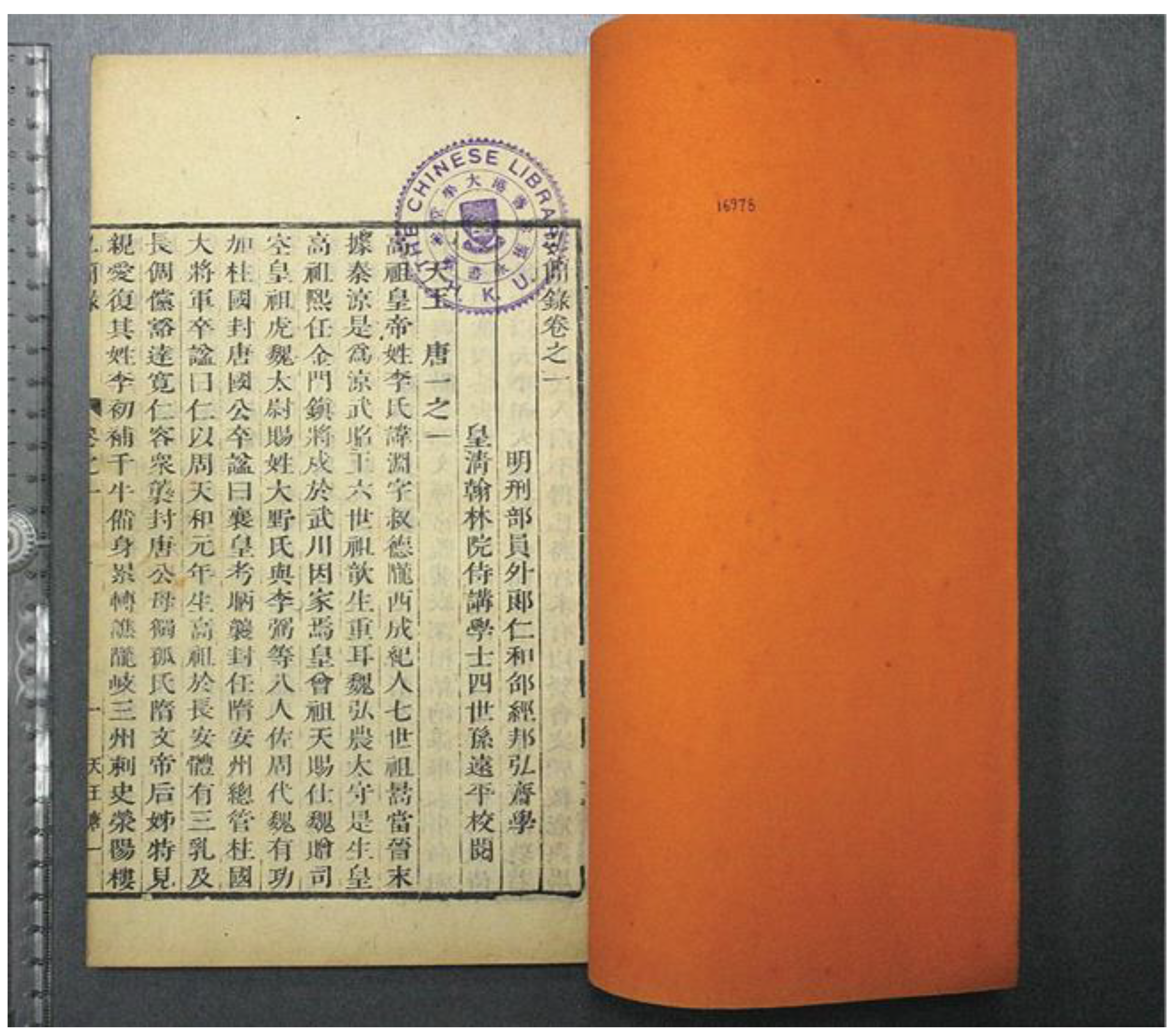
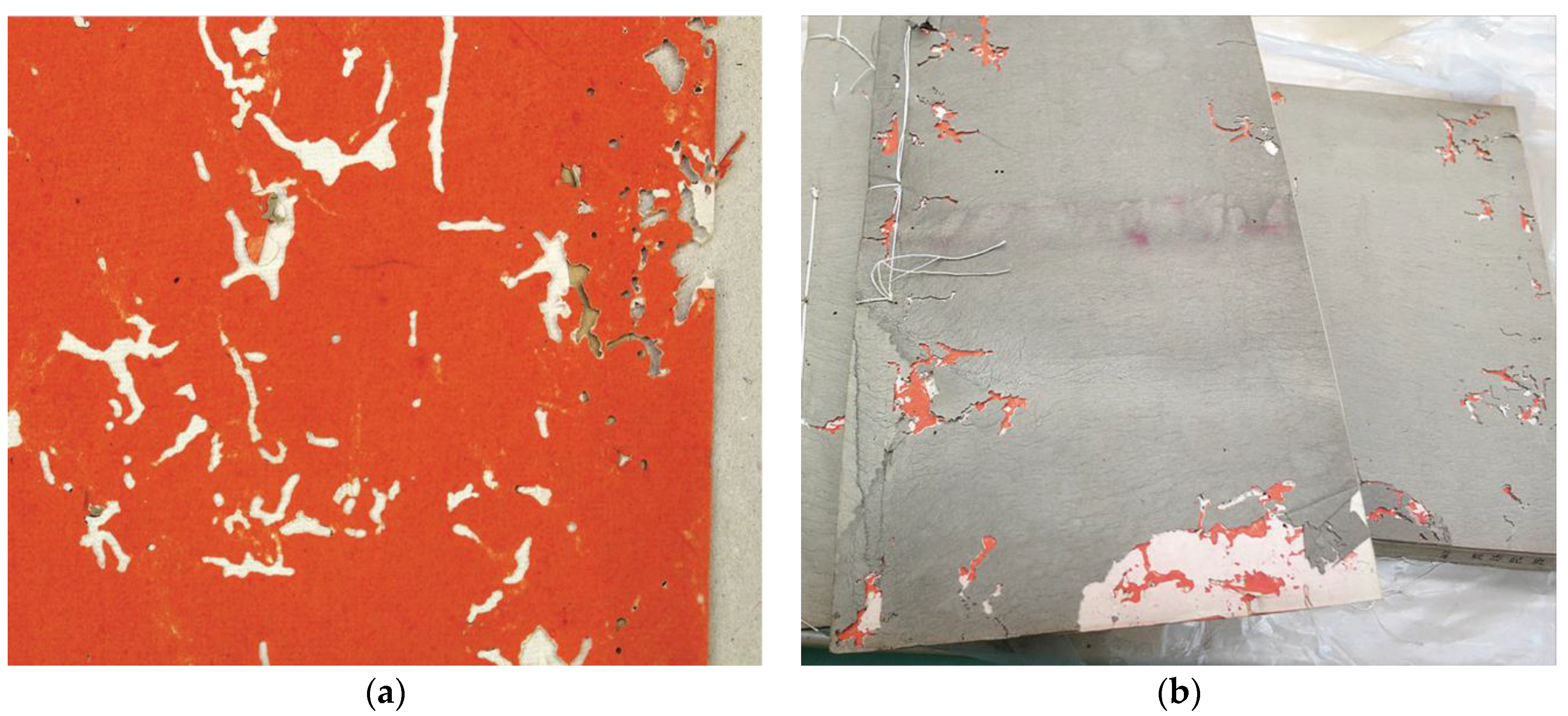
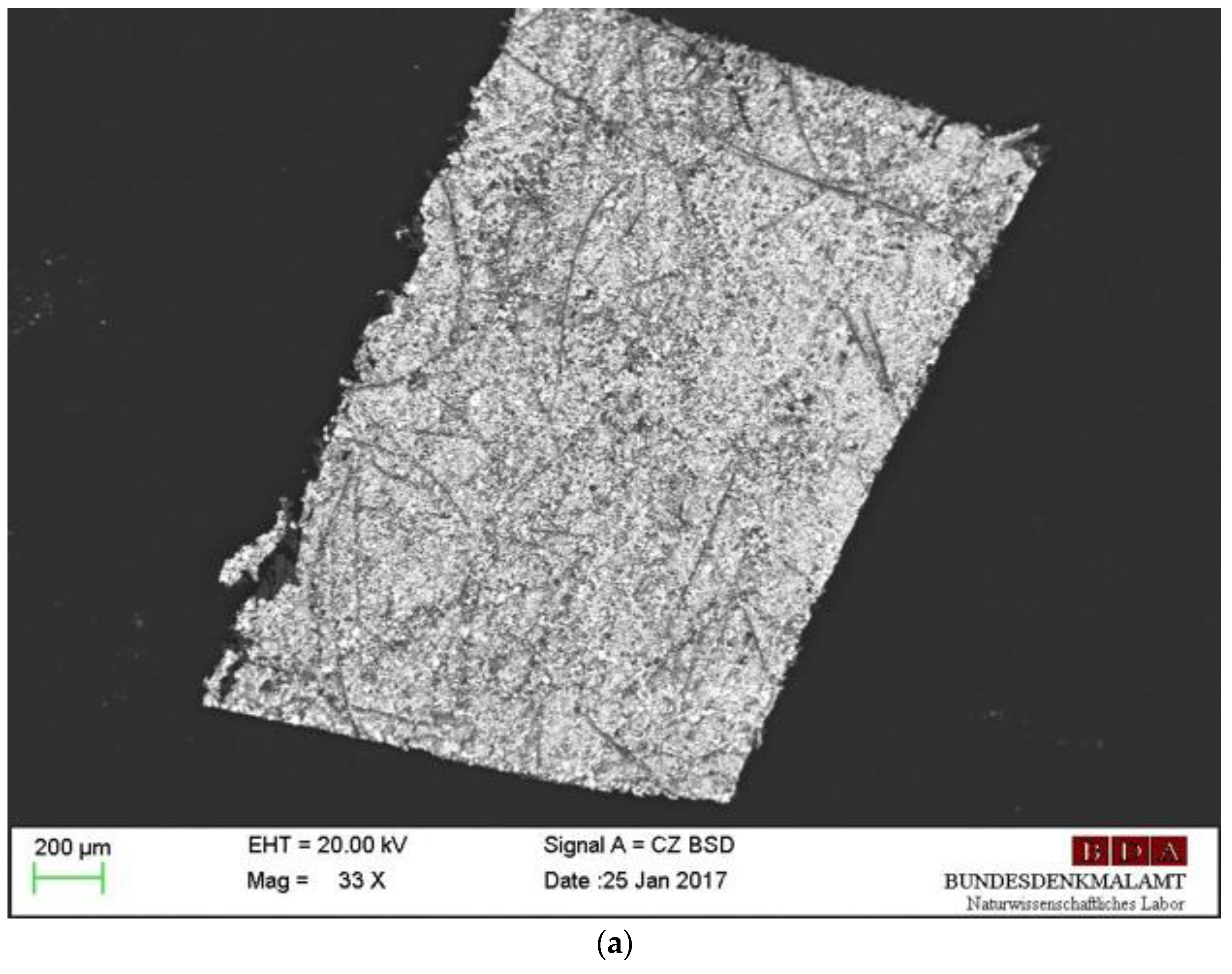
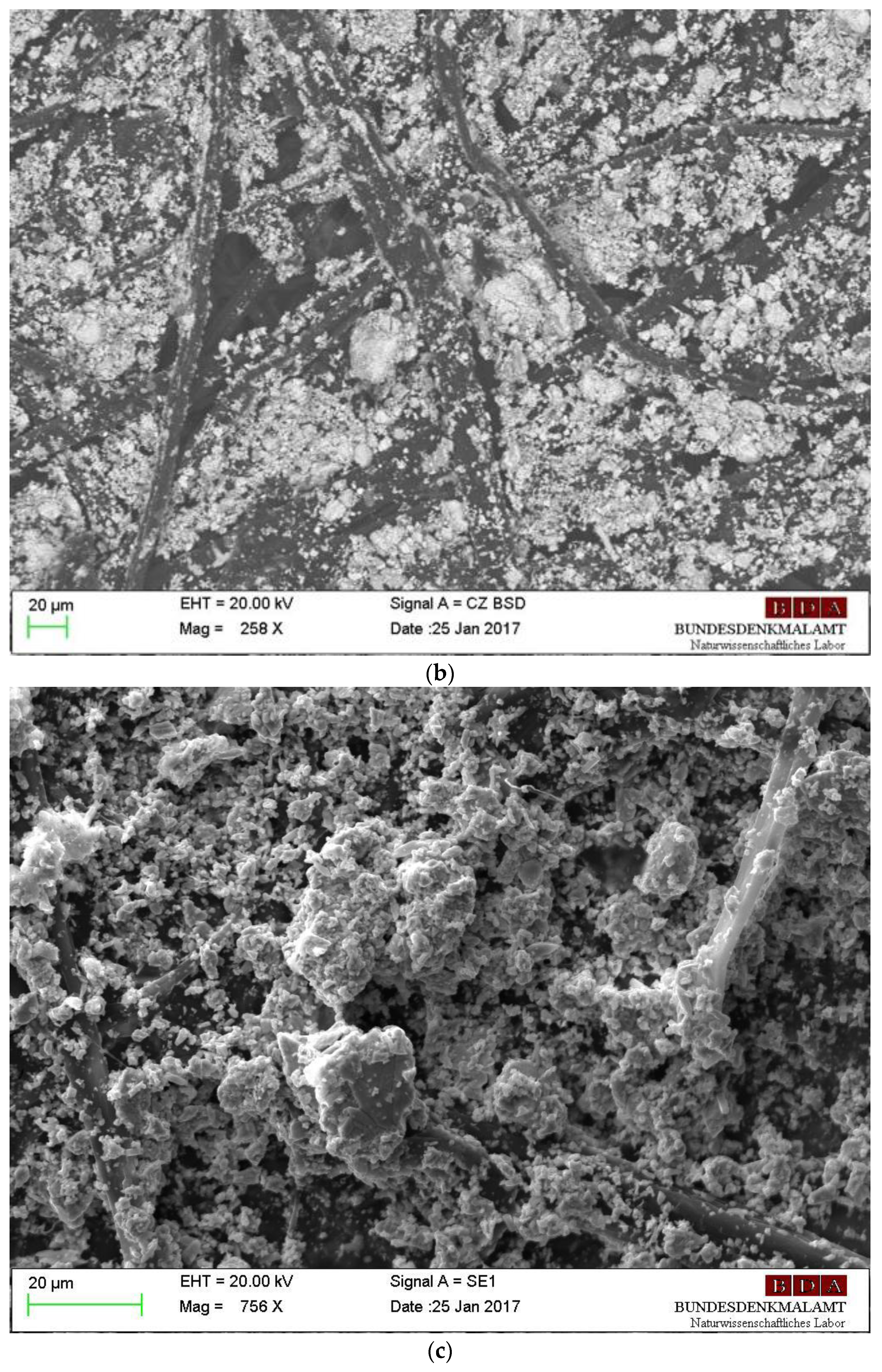
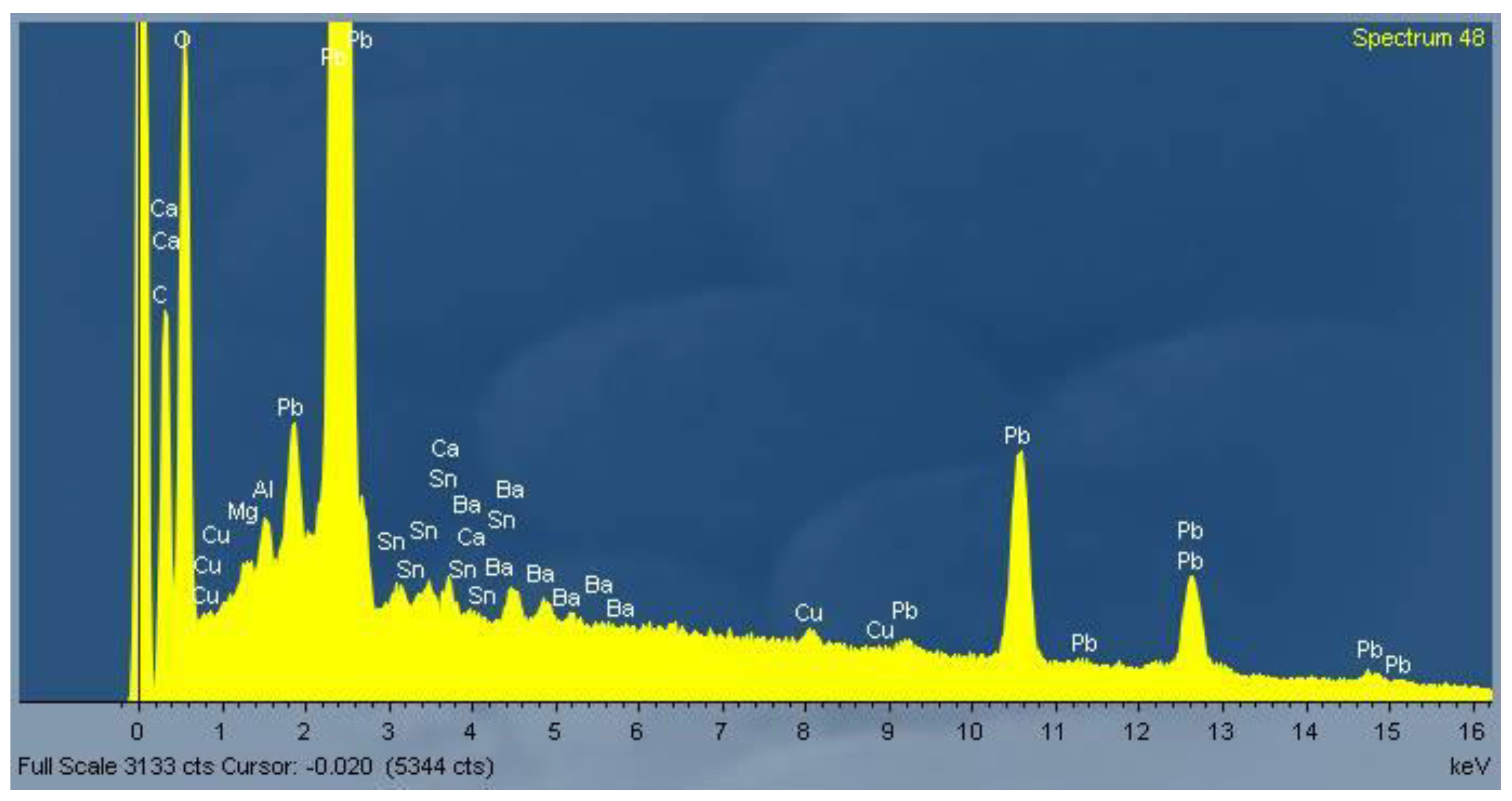

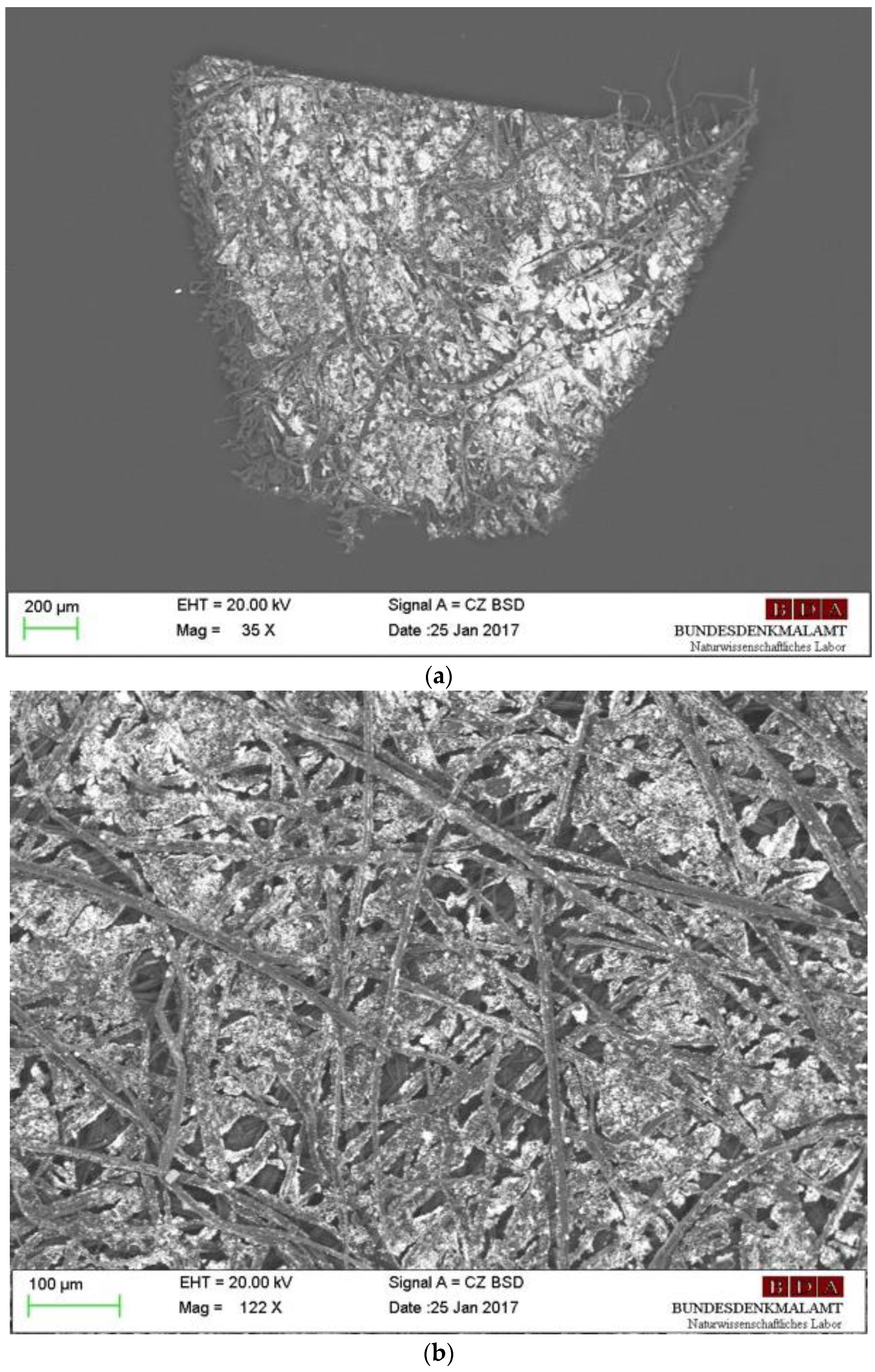
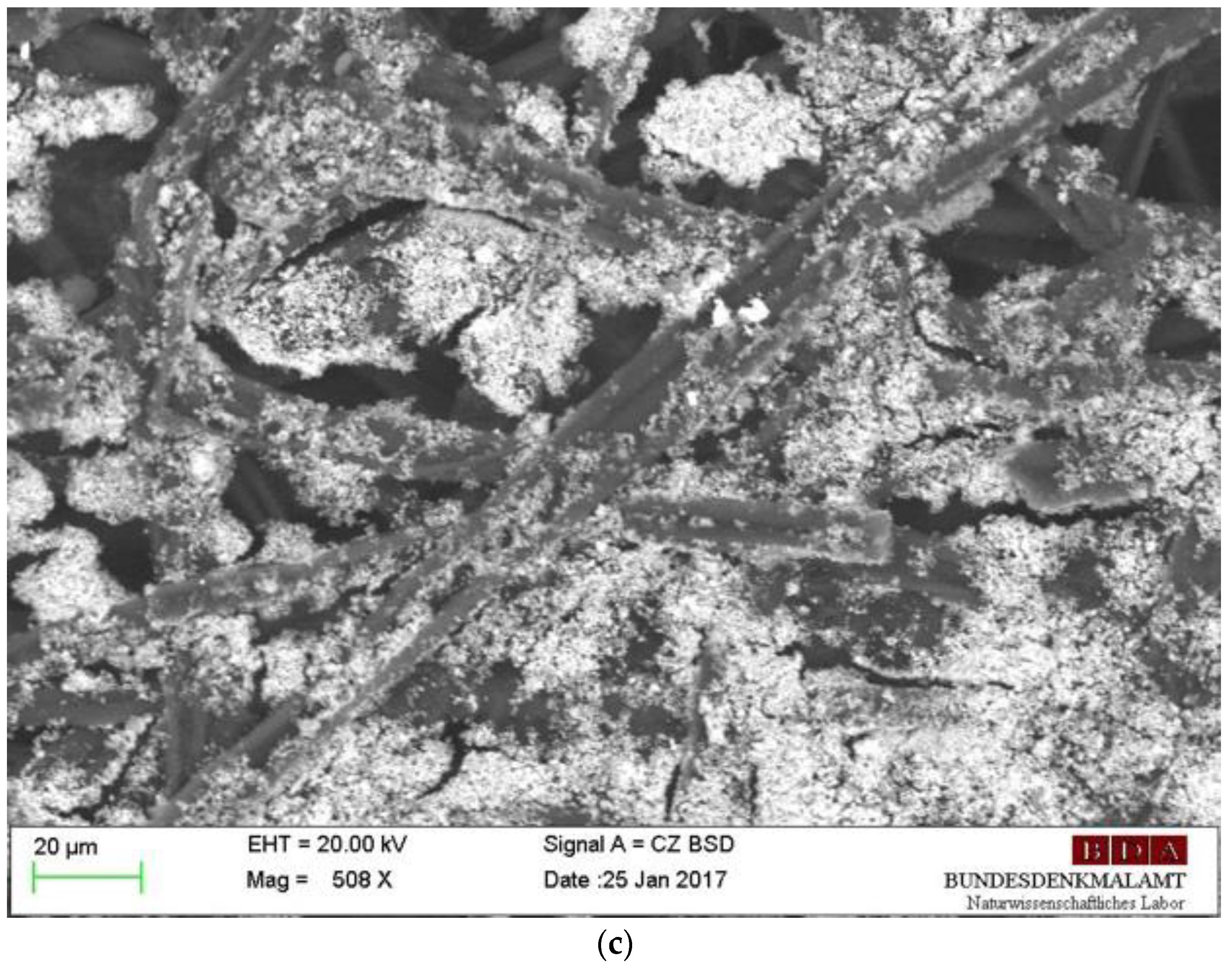
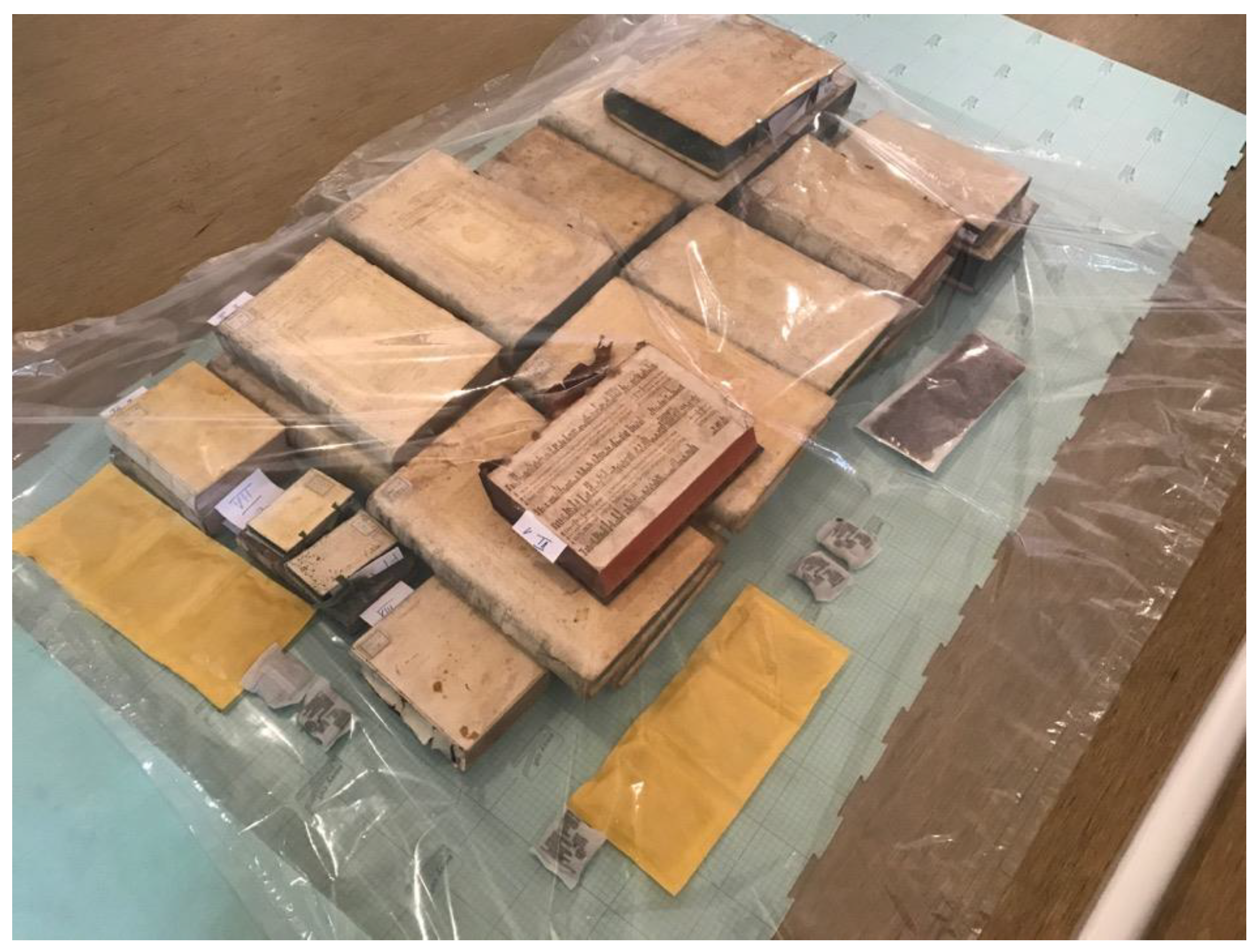
Publisher’s Note: MDPI stays neutral with regard to jurisdictional claims in published maps and institutional affiliations. |
© 2022 by the authors. Licensee MDPI, Basel, Switzerland. This article is an open access article distributed under the terms and conditions of the Creative Commons Attribution (CC BY) license (https://creativecommons.org/licenses/by/4.0/).
Share and Cite
Querner, P.; Beenk, J.; Linke, R. The Analysis of Red Lead Endsheets in Rare Books from the Fung Ping Shan Library at the University of Hong Kong. Heritage 2022, 5, 2408-2421. https://doi.org/10.3390/heritage5030125
Querner P, Beenk J, Linke R. The Analysis of Red Lead Endsheets in Rare Books from the Fung Ping Shan Library at the University of Hong Kong. Heritage. 2022; 5(3):2408-2421. https://doi.org/10.3390/heritage5030125
Chicago/Turabian StyleQuerner, Pascal, Jody Beenk, and Robert Linke. 2022. "The Analysis of Red Lead Endsheets in Rare Books from the Fung Ping Shan Library at the University of Hong Kong" Heritage 5, no. 3: 2408-2421. https://doi.org/10.3390/heritage5030125
APA StyleQuerner, P., Beenk, J., & Linke, R. (2022). The Analysis of Red Lead Endsheets in Rare Books from the Fung Ping Shan Library at the University of Hong Kong. Heritage, 5(3), 2408-2421. https://doi.org/10.3390/heritage5030125




